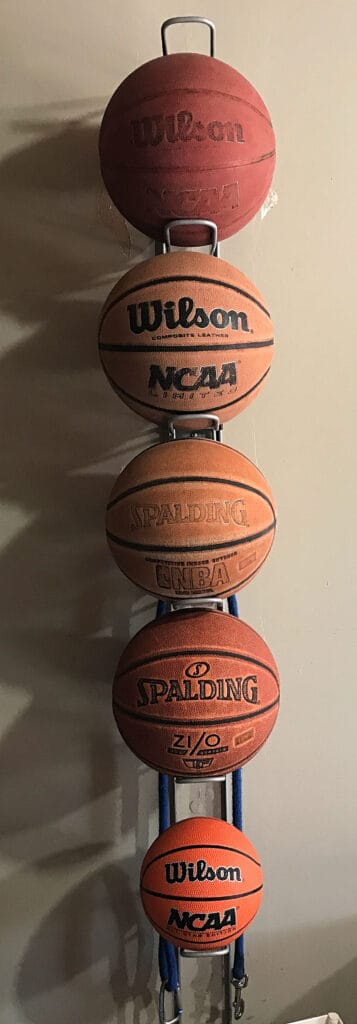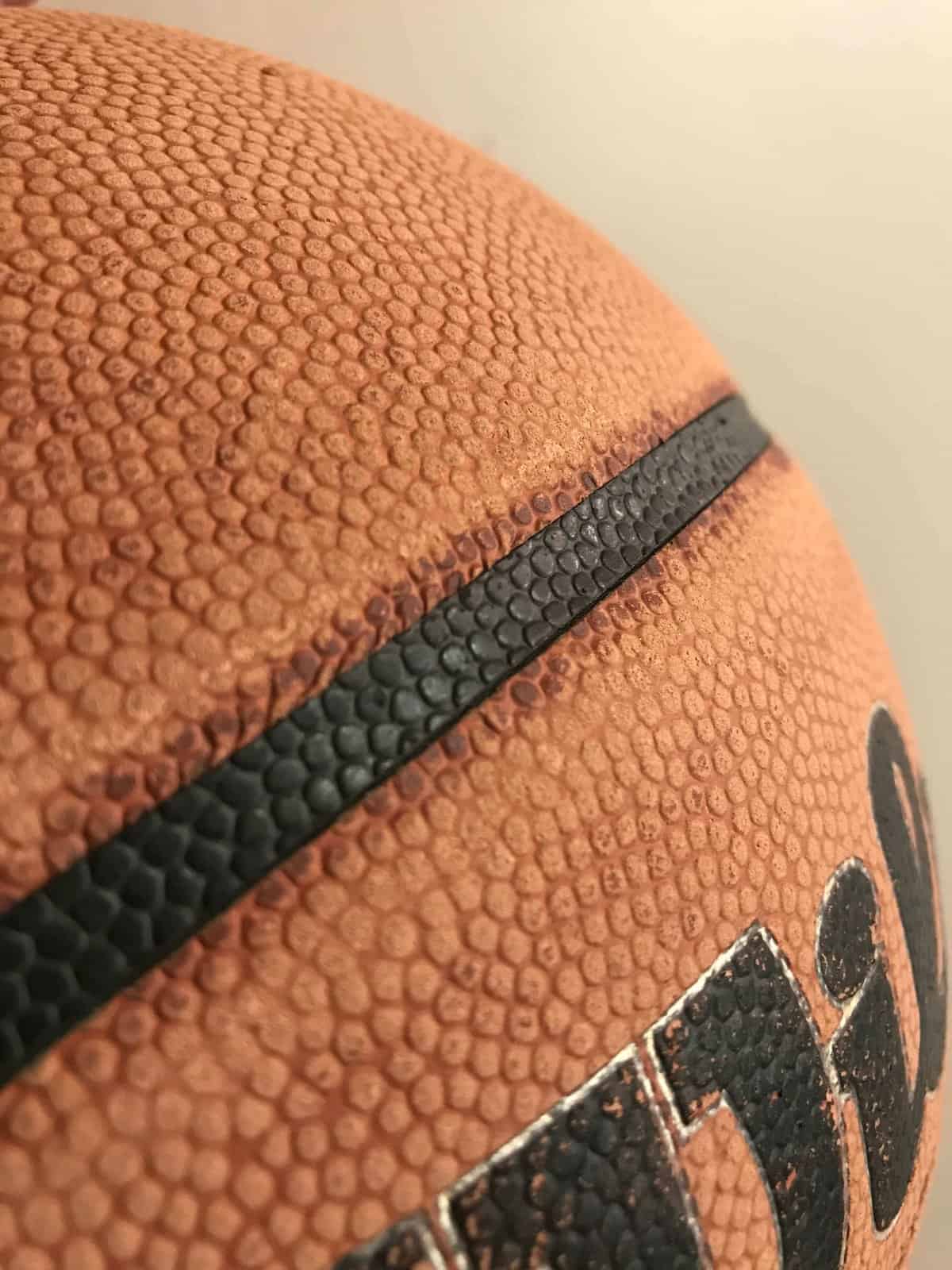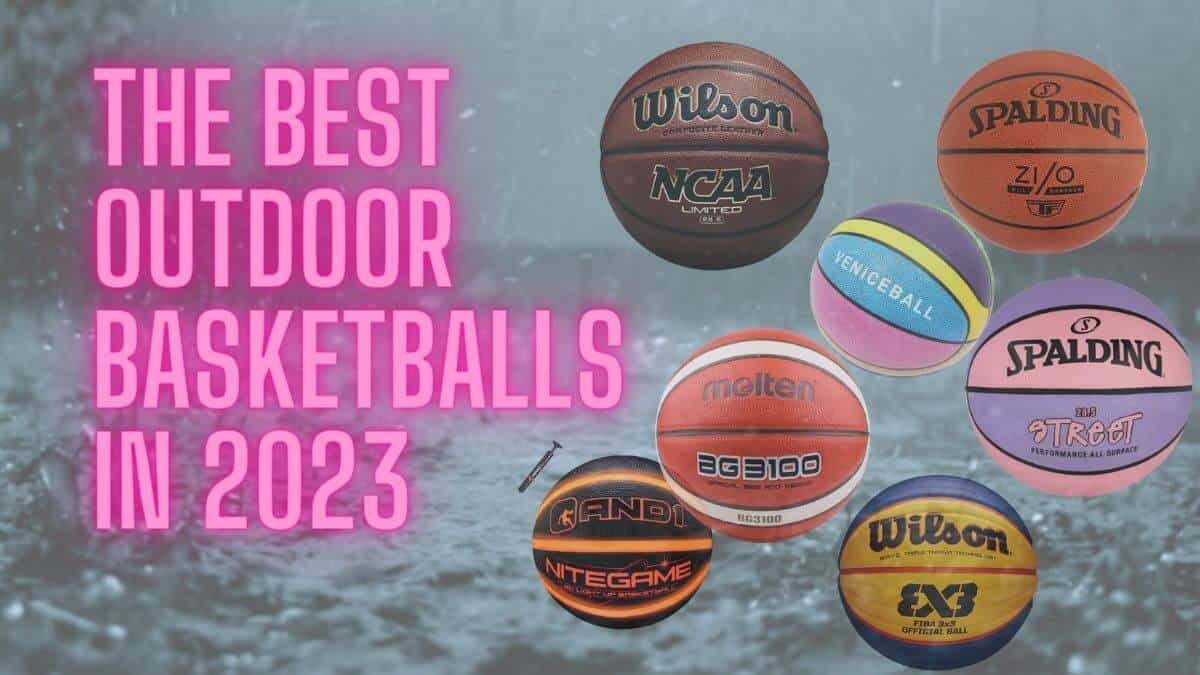When you make a purchase through links on this post, we may earn a commission through Amazon or other retailers. Learn more about our affiliate disclaimer.

Alright, let’s not waste too much time here that can be better spent on the court.
You want a basketball that’s gonna perform, but also hold up to the pressure. And you want a ball that speaks to you, to your singular aesthetic, and to the unique way that you play, even if maybe you haven’t found it yet.
Conveniently, there are only a few basketballs that are worth your time. I’ve put hundreds of hours on all of the common models, so you don’t have to.
Just Give me the Best Basketball You Got!
We’ll break down some of the details to look for in outdoor basketballs below, but if you just want my pick, here it goes…
for a full-sized, all purpose, men’s ball, go with the Wilson NCAA Indoor/Outdoor
If you’re only going to play indoors, and you’re willing to spend a little more, go with the Wilson Evo, which is about as close as you want to get to an official NBA game ball (around 200$).
Bu for most practical purposes, the Wilson indoor/outdoor is just the right choice. There are 4 details that make this the best outdoor basketball available in 2024…
- It’s very consistently available in the Wilson store on Amazon. Sometimes, the right shopping choice is just too obvious. The Wilson store is reliable and you’ll have someone to complain to if you’re not happy with the product. You can also be confident you’re getting a genuine ball. Fake basketballs aren’t wildly common, but they are a legitimate problem when you’re buying online.
- It’s durable. Seriously! Mine has held up better than any outdoor basketball I’ve ever played on. In fact, as my Wilson started to age, I picked up a Spalding TF-250 to replace it (also a solid option, particularly if you prefer the 28.5″ standard for women’s and under 14 play). My Spalding is fresher, but I keep going back to the old Wilson because I just love it and it feels great to play with. The seams aren’t even splitting or cracking. I’m genuinely impressed that this thing just seems to get better with age. Even after hundreds of hours on funky black top, my old Wilson basketball still feels nice and still has some grip.
- It’s reasonably priced, a little more expensive than the Spalding TF-250, but way better than all of the cheaper models.
- It’s widely available in all sizes and several styles. It’s just nice to have a standard basketball you can rely on, across leagues.

Pick one up and get hoopin’. Seriously, you’re gonna want one of these in your quiver. Here’s mine.
What to look for in an outdoor basketball
As much as I recommend the Wilson NCAA Indoor/Outdoor, I know it’s not going to work for everyone. So I wanna walk you through some details to look for in finding the best outdoor basketball available.
We’re looking for a basketball that feels good and responsive in your hand. You want a grip that agrees with you, and that can be a very subjective thing. But you want that feel to sustain itself over hours and days of play. More than durability, you want an outdoor basketball that ages to perfection.
The Best Material for Outdoor Basketballs
Most hoopers will agree that a leather ball is ideal. But leather is expensive and it’s a bit of a shame to let a leather ball touch an outdoor court, unless maybe it’s had a long and full life on hardwood.
So for an outdoor basketball, you only have 2 options in terms of material, rubber or composite. A leather composite basketball will be a little pricier. Some players like rubber, but very few prefer it.
Personally, a rubber ball feels cheap and impersonal. They don’t hug your hand. The bounce is a little harsh. I’d gladly pay more just for the hand feel of a composite basketball. And at this point, a quality composite ball should last as long as rubber, as long as you don’t soak it in water. The only persistent benefit of a rubber basketball then, is that they’re easier to keep clean.
There’s also the idea that a composite basketball can double as an indoor basketball, while a rubber basketball is even worse on an indoor court. This logic doesn’t really work for me. I am a believer that you should have dedicated indoor and outdoor basketballs. And as soon as your indoor basketball hits asphalt, it is officially an outdoor basketball.
Grip and Feel
Let’s zoom in on grip a little. This is the most personal of details. I need a firm but subtle grip and a nice crease on the seam that I can sink my fingertips into. And ideally, I want that surface to improve with wear. That’s a lot to ask from sphere of composite leather.
Like I said, I just love the Wilson NCAA Outdoor. It has enough give that it still feels like handling an indoor basketball. But it holds up. I was recently playing around with a brand new Spalding Zi/O which also has a pretty decent feel. But there’s just something a little gummy and hard about the Zi/o that doesn’t work for me.
I honestly prefer playing with my Wilson even though it’s got an easy 200 hours on it. Not to mention that an older Spalding I have laying around is peeling and nearly unplayable after less time on the court than the Wilson. Given that the Wilson is only a little more expensive, it’s the obvious winner.
Durability
Honestly, outdoor basketball durability is basically impossible to evaluate. To really test the durability of a street basketball you need to put 100’s of hours of outdoor court time on it.
And even when you’ve evaluated one ball, that doesn’t mean every ball that comes off the assembly is the same, or that they haven’t changed some detail of the process since you got yours. I’ve seen it first hand, 2 of the exact same model outdoor basketballs, wearing in completely different ways.
But durability is an essential feature of the best outdoor basketball, so we can’t just ignore it. To explore the idea of durability I’m looking at reviews with an eye for production issues specifically. We’ll check out some images of wear and do our best to dig into structure. We know that certain features have a higher failure rate, so those features are to be avoided
How do outdoor basketballs wear out?
- Punctures – I’s not easy to puncture a basketball on accident. But I have done it. Somehow I hit an acacia needle head-on. Instant flat. I can’t exactly blame ball-quality for this one. But in general, punctures are not much of a concern with quality outdoor basketballs.
- Delamination – The outer surfaces can sometimes begin to peel away from the core of the ball. A good quality ball shouldn’t delaminate. However, you need to keep your ball out of the water. Play in the rain, let your basketball dry out, and you will get cracking and delamination.
- Peeling – similar to delamination, where the panels begin to separate, I’ve seen plenty of examples where the very top surface of the ball begins to flake and peel. This is one of those things that just happens with age. But it has been more pronounced for me on Spalding balls.
- Cracking – give it long enough, most balls will start to crack. But this tends to be more common with the more rubbery balls. I’ve had a ‘composite’ ball do this too, but it’s no the best ‘composite’.
Spotting a durable outdoor basketball

- Check the seams– This sounds a little silly but it’s the first thing I look for on a basketball. The seams should be well-integrated with the panels. I particularly like seams that are dimpled. A seam that is obviously a different material and shows a clear division between the seam and the panel is a red flag in durability.
- Brand– Just make sure you go with an established brand. There are a ton of wonky brands out there with no desire to compete on quality. They manufacture cheap products and lean on clever listings and weird styling to try and separate you from your cash. Wilson, Spalding and Molten are strong brands. And 1 as well, but they make mostly rubber balls.
- Inflated – It’s pretty common to deflate basketballs for shipping. This is an incredibly lame move. You don’t want your basketball flattened and crammed into a box. It should come fully inflated and ready to roll. The folds that can form when a ball is deflated and folded are difficult to remove.
- Fakes – Yes, seriously. If you’re not careful, you can end up buying a fake basketball if you’re shopping online. You can help avoid this by shopping through major retailers or using brand-official shops on Amazon. Otherwise, you are taking a bit of a chance.
Style
You gotta be you, right. But if burnt umber isn’t working for you and you’re thinking of branching out on the style spectrum, there are some things you should know.
First of all, a lot of leagues have styling restrictions. On the off-chance you’re thinking of trying to use your ball in league play of some sort, stick with the classic burn orange. Even the relatively common darker colors are a no-go.
And if your decision is based on aesthetics, you’re almost definitely sacrificing something in terms of quality. That being said, there are plenty of options out there.
The Wilson NCAA comes in several styles. But if you’re really all about style over quality, go with And1. The Fantom is cheap, comes with a ball pump, and comes in a bunch of colors. There’s even a glow in the dark model. Any other company producing stylized basketballs is likely to be very low quality.
Basketball Sizing
There are generally 4 sizes you’re interested in. Full-size is commonly listed as size 7 (29.5″). This is what’s used in the NBA and NCAA Men’s basketball. Size 6 (28.5″) is what goes for WNBA and boys 12-14 leagues. And for the little ones, size 5 (27.5″) is intended for the 9-11 age range and and size 4 (25.5″) is intended for the 5-9 age range.
Caring for your outdoor basketball
Any basketball that’s not full rubber is not going to be friendly with water. Even a quick session on a court that’s still moist from a recent rain can be enough to destroy your ball.
So you wanna just take generally good care of your ball. Avoid getting it wet, leaving it outside, or just letting it bang around while not in use. You might consider a simple ball rack if you’ve got the space for it. It’s nice to have a place for your basketballs to call home.
Outside of just having that general respect for your stuff, there’s really only one key maintenance concern for outdoor basketballs. You want to do your best to maintain proper air pressure.
If you don’t have a good bike pump laying around where you can get an accurate pressure reading, get yourself a good ball pump with a pressure gauge like this one.
The correct air pressure for a standard basketball is 8 PSI. Surprisingly, most ball pumps will not include a pressure gauge, expecting you to be able to judge air pressure by feel.
Takeaways
The best outdoor basketball is the one in your hands. Even if you’ve gotta take the cheapest rubber basketball you can get your hands on, it’s still a basketball, and you’re still playin’.
But if you have the means, I highly recommend investing in the proper equipment. The hooping experience is greatly augmented by a quality basketball that will improve over time.
So while I hope I’ve helped guide you towards an outdoor basketball that’s gonna hold up for months and months of play, I also hope you’re gonna get out there and hoop with any outdoor basketball you can get your hands on.

